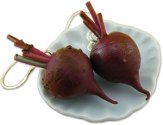Polymer garden delights

Inspired by Christine Dumont’s hollow bead online course, Kukel10 has built a big bead garden ornament that becomes even more interesting up close.
Ruffles, spikes, dots and disks, sit atop stripes and poetry. This piece will spark many conversations in her garden.
As long as we’re touring the garden, take a look at Shay Aaron’s polymer clay beets, radishes and other vegetable delights to wear.

There’s even more food jewelry on his Etsy site. If you have a hankering to grow something polymer, follow one of Shay’s tiny veggie tutorials.












